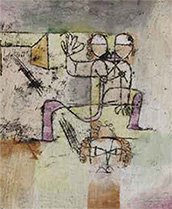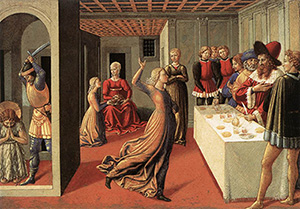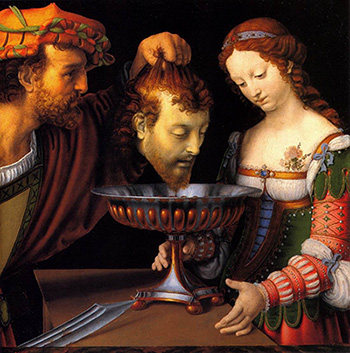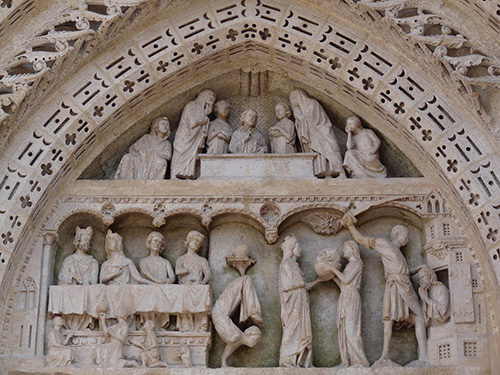-
Salome: How to do the Seven Veils
By Danielle D'OrnellasPosted in 2012/2013By Nikita Gourski, Development Communications Officer

Imagine the choreographer who turns to the libretto of Salome for the first time, looking for insight on the famous Dance of the Seven Veils. They find only the briefest and most general of instructions to guide their work: “Salome dances the Dance of the Seven Veils.” For a pivotal scene, it’s not much to go on.
Yet that brevity opens up the performance to a multitude of possible and legitimate interpretations. By saying next to nothing about how the dance should look, the libretto seems to recognize that an elusive and indefinable quality is woven into the dance… a quality that might resist pre-determined charting precisely because it originates from a mysterious place of self-expression.


Salome by Paul Klee, 1920 and The Dance of Salome by Benozzo Gozzoli, 1462Salome was adapted from Oscar Wilde’s one-act play, in which the author omits specific choreographic instructions with the very same phrase that the opera’s libretto echoes, unchanged, 13 years later. Things only get more puzzling when we read Wilde’s personal inscription to illustrator Aubrey Beardsley. “For Aubrey,” Wilde wrote, “the only artist who, besides myself, knows what the dance of the seven veils is, and can see that invisible dance.”

The Stomach Dance by Aubrey Beardsley, 1894Treating these remarks seriously for a moment we get Wilde insisting that (a) the dance is not only – or even primarily – a physical happening; and, (b) its main processes aren’t perceivable in the visible realm. This alters our thinking about the dance in a pretty radical way: rather than a set of gyrations to be exhibited in the outer world, it’s now understood as a ritual aimed at Salome’s inner life and the spiritual (read: invisible) world.
Shireen Malik, a choreographer and dance scholar, has recently speculated that Wilde’s ideas about the Dance of the Seven Veils might have been informed by an ancient Mesopotamian myth, in which the goddess Ishtar descends into Hades. As Ishtar journeys deeper into the underworld, she needs to pass through seven gates and leave behind an article of clothing or a piece of jewellery at each of the successive entryways.
That's certainly consistent with Wilde’s suggestion of a dance that functions more like an invisible personal journey than a physical display. And its connection to Mesopotamian mythology underscores the fact that the dance has a vast history that precedes the 19th century’s Orientalist construction of it.

The Apparition by Gustave Moreau, 1876
One of the most popular 19th-century portrayals of SalomeVeils, for example, were not associated with Salome or her performance at Herod’s banquet until 1870, when Arthur O’Shaugnessy introduced the image in his poem “The Daughter of Herodias”:
She freed and floated on the air her arms
Above dim veils that hid her bosom’s charmsOr consider this typical Renaissance portrayal, in which we find a subdued and even somewhat dignified Salome, showing no traces of the vampiric, sexually frenzied attributes that so fascinated the 19th-century artists.

Salome with the head of John the Baptist by Andrea Solario, 1520-1524Contrast that with the prevailing depictions of Salome during the Middle Ages, in which her dance is realized as a kind of acrobatic heathen act, replete with tumbling and contortions.

Detail of a Rouen Cathedral tympanum. Photo by Will Collin
As rendered in a tympanum of the Rouen Cathedral, Salome’s dance is an act of sinful aberration: walking on her handsSo the teenaged princess Salome had been dancing across the collective imagination of Western Europe for hundreds of years before Richard Strauss ever set her dance to music.
As always – and as never before – Salome dances the Dance of the Seven Veils.
For more on the ideas behind this post, check out the work of scholar Daria Santini; Shireen Malik’s article “‘She freed and floated on the air’: Salome and Her Dance of the Seven Veils” (collected in The Veil: Women Writers on Its History, Lore, and Politics edited by Jennifer Heath); and, Salome and the Dance of Writing: Portraits of Mimesis in Literature by Françoise Meltzer.
Photo: (top) Dance of the Seven Veils scene from the Canadian Opera Company’s production of Salome, 2013. Photo by Michael Cooper
